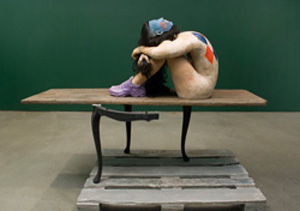Art's Vicious Circle
John Haberin New York City
Skin Fruit: The Dakis Joannou Collection
When Urs Fischer took over the New Museum, he promised to shake the building to its foundations. He had already dug a huge pit in his gallery. When the museum show turned out unbearably stylish and tame, that shook things up, too.
So did the follow-up, an entire museum devoted to Fischer's biggest collector. "Skin Fruit," from the Dakis Joannou collection, made people angry from the moment they heard about it. Even the idea's defenders sound at best resigned. Peter Schjeldahl settles for observing that collusion reflects the state of the arts. 
But does it, should it, and does it have to? This exhibition itself only makes things worse. It also obliges one to look back at what lay at stake from the start. Art can never look good trapped in such a vicious circle.
Boys will be boys
I was dreading the Dakis Joannou collection. The power of the patron has come a long way since Gertrude and Leo Stein. Turning the New Museum over to a wealthy trustee had people angry for a reason. It sounded frighteningly narrow, not to mention corrupt. But who knew it would come down to a single artist? True, "Skin Fruit" lists about a hundred works by fifty artists, but consider the evidence.
Obviously this Tim and Sue Noble, Kiki Smith, and Janine Antoni are one and the same, with their hairy primitive humans. This person may accentuate the scale a bit under the name Charles Ray or Ashley Bickerton. He may become a warrior-god under the name Pawel Althamer, David Altmejd, or Roberto Cuoghi. He may chuckle over male private parts directly, with Cuoghi's snake penis and scorpion tail, or just as obviously with big red noses facing a fiberglass Paula Jones, supposedly by Paul McCarthy. He may smooth bodies out a bit in the face of death, as Andro Wekua, Maurizio Cattelan, or Mark Manders. He may clean up the lifeless casts still further as Robert Gober, infantilize them as Takashi Murakami after Hiroshige, or render their hulk in found shreds as Elliot Hundley.
As John Bock, he adds the obligatory car wreck to explain the deaths. He may work in other media, as with Haris Epaminoda's hirsute video or a nagging performance in song by Tino Sehgal. With a funnier video, as Vanessa Beecroft, he may prove that blonds really do have more fun, at least in a male playground. He may stretch turds into a black handrail as Urs Fischer or Franz West. He may cover them in white chocolate as Terence Koh before Koh's ritual phase, incorporate them in painting as Chris Ofili, or simulate child's play with them as Adam Helms. He may simply pretend to spray paint Holy Shit as Dan Colen.
He may harp on cavemen again through Altmejd's totem The Cave. Like Mike Kelley, he attempts a black-and-white Cave Painting. Practically the same design takes on mural scale in the lobby as avaf's Tom Cruising. Still, it all comes down to the topic of Matt Greene's The Orifice—or Nate Lowman's all too similar black hole. But pretty much any orifice will do. As Nathalie Djurberg, the artist proves that you can literally fuck yourself—at least in claymation.
Kidding aside, children have more imagination than this, and so should even the most childish art. Boys will be boys, but the uniformity that they impose takes a special toll on the handful of women, almost all exceptional artists in their own right. Smith and Antoni were laying on the line a woman's vulnerability, not offering it up for male leering, and Djurberg's second video laughs bitterly at her character's compulsion to play along. Cindy Sherman turns up, but at her most extravagant and degraded. Paul Chan turns up, too, but with Orgy and not sad silhouettes of disaster—a highlight of "Haunted" now at the Guggenheim. For this collection, abjection is not a threat to the psyche or to meaning itself, but a woman's destiny.
One could blame the artists or the curator, Jeff Koons, and one should. One could blame the fashion for overblown shows and overblown reputations, although "Skin Fruit" looks like ancient history already. (It also sounds like a mistranslation from Joannou's original Greek.) Still, Koons shows surprising restraint. He includes just one of his own works. In this context, his 1985 basketball in a fishtank looks downright handmade.
A museum's shakedown
I put the blame squarely on the museum, for a sorry display of art as boy toys. In real life, one often admires toy makers. They just make a bad model for adult art. Here even Ray's ghostly merry-go-round appears not an exercise in art and perception, but a wealthy man's playground equipment. The horses move backward, but forward relative to the base, which turns backward more quickly still—not unlike the museum. The wheels of art turn round and round, the painted ponies go up and down, and money is greasing them.
Fischer's failure just months before underscored how quickly he had advanced, thanks to much the same grease. It took him in barely three years from outsider to a Whitney Biennial, a West Village dealer, and now three entire floors of a museum founded as an alternative space. And when the New Museum announced "Skin Fruit," it felt like a shakedown. Here it was—the very next show for a collector who has invested in Fischer, curated by Jeff Koons. It promised to move everyone involved to the center of the art world. Koons, of course, was there all along.
It took a few months to attract attention, but it became an embarrassment. Tyler Green and other bloggers screamed. Meanwhile William Powhida made the nexus of connections notorious with cover art for the Brooklyn Rail. Jerry Saltz defended the museum, hardly for the first time, at New York magazine. Edward Winkleman—the dealer, blogger, and now author—suggested a debate, and he was only half kidding. A little public scrutiny of a museum's mission, conflicts of interest, and connections is long overdue.
 Then again, a debate might complete contemporary art's transformation from high culture into a public spectacle. The flare-up already reflects the transformation. Green writes as a blogger—quickly and archly reacting to other news sources. Saltz continued the discussion on Facebook, a story I tell elsewhere. I do not play the game well, whether as Web critic, amateur theorist, or pretend art historian. I tried to save my outrage until the Dakis Joannou collection opened, honest. But what, if anything, is wrong?
Then again, a debate might complete contemporary art's transformation from high culture into a public spectacle. The flare-up already reflects the transformation. Green writes as a blogger—quickly and archly reacting to other news sources. Saltz continued the discussion on Facebook, a story I tell elsewhere. I do not play the game well, whether as Web critic, amateur theorist, or pretend art historian. I tried to save my outrage until the Dakis Joannou collection opened, honest. But what, if anything, is wrong?
Plenty. A museum needs a better reason to display a private collection—especially one that hardly languishes for attention. The New Museum does not even claim a particular insight into contemporary art, as would a typical group show. Instead, it flatters one man's taste, caters to wealth and ego, and represents a clear conflict of interest. It entangles a museum, a trustee, Fischer, Koons, and outsize reputations in a hungry market. It might as well pronounce the recession over all by itself.
So what if the New Museum has no permanent collection, while the Guggenheim descended to begging the Nasher collection for sculpture? An exhibition like this still certifies private interests as museum quality. It still fills the building, and it still rewards a trustee's contribution to its endowment. It cannot even claim the museum's mission, of exposing the public to art on the edge or the multiplicity of a global art world. While Joannou does collect artists back home in Greece, the show includes exactly two. Not that it helps much to augment shallow celebrity art with obscure Greek imitators of shallow celebrity art.
The place of private collections
It also testifies to the abysmal state of the New Museum. I first saw William Kentridge at the New Museum on Broadway, in Soho, and he has only now come to the Museum of Modern Art. Since reopening on the Bowery with a rainbow Hell Yes out front (by Ugo Rondonine), the museum has fallen over itself to enter the mainstream. It has had vacuous group shows. It has had themes that echo Chelsea's macho displays of trashing the gallery. I try to enjoy the irony that one such theme was "Unmonumental."
It has had yet another display of emerging artists, midcareer bloat for Fischer, and now this. Frankly, I had never cared for Marcia Tucker's judgment as the museum's founder. As Roberta Smith put it in The New York Times, she could be "infantile, sterile and hectoring, sometimes all at once." Tucker might love the stridency of Black Panther posters at the museum this past summer. Still, Lisa Phillips has left a grassroots program far behind. As director, as at the Whitney before that, she is determined to play trend spotter in a trend-obsessed art scene.
The tangle extends to the media. Not all that long ago, the New Museum struggled for press coverage—a testimony to Tucker's integrity and the media's savagery. Try to name another show in its past homes, beyond maybe Andrea Zittel. All at once, in a costly new building, it has gained near universal praise. The Joannou collection brings almost the very first dissents. Even then, it is all too easy to blame the display on Koons.
What if he had made the show work? The real question is what if he could not. And the architecture's dysfunction becomes more and more obvious. All this parallels the difficulties facing other museums. They, too, lose when they accept the truism that art is a commodity for the rich and a career opportunity for others. The public loses for sure when it cannot sort out hype from curatorial ambitions in phony attributions at the Met.
Museums should collaborate—with private collectors and with each other. They do so on traveling shows and in exchanging loans, and no one should mind if the loans sometimes hog the spotlight. The Frick shone with selections from the Norton Simon, and it is doing so again with loans from Dulwich Picture Gallery in London. Dealers have every right to collaborate among themselves, too, on art fairs, a collaboration that Tyler Green also disdained. They are a business venture, but so what? Week after week, they invite you to judge for yourself how well they represent the state of the art.
Even exhibitions of private collections have their place. Sometimes no one can resist a peek, to catch the art long and the buzz. When MoMA accepted work from Edward R. Broida, it did everyone a favor by putting it on display before integrating it with the collection. The show gave the acquisition greater transparency—and gave the public a window onto the 1970s. And collectors from Albert C. Barnes and Solomon R. Guggenheim to Emily Fisher Landau are entitled to take their vision to the public as museums. But this time Green is right, and a museum betrays its trust.

"Skin Fruit" ran at the New Museum through June 6, 2010.




